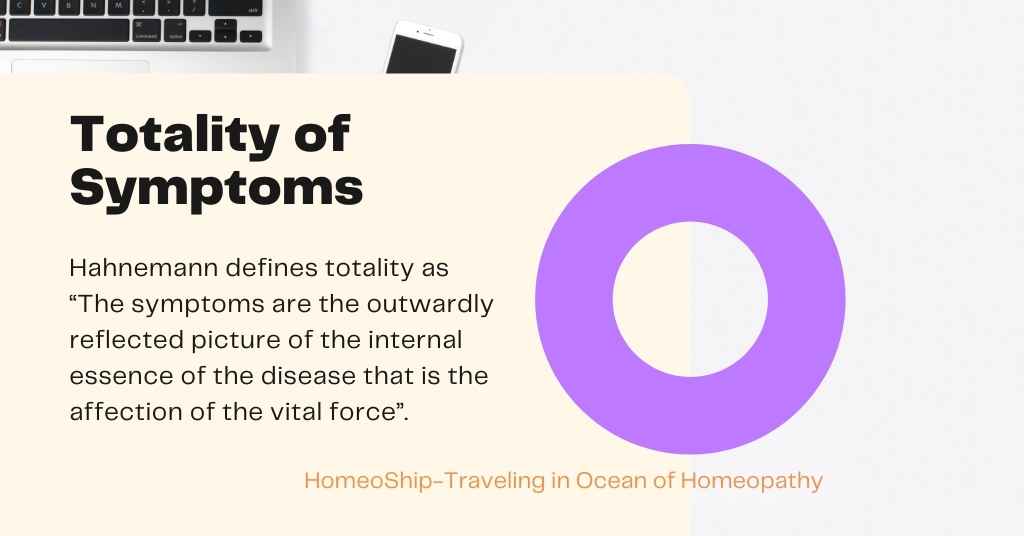Contents
Man is known by his actions, sensations, and functions exhibit his health status. In the same way, his diseased state is nothing but an alteration in his sensations and functions. So, investigation of the disease is done by identifying these alterations in the previously healthy sensations and functions, which in a broad sense can be called signs and symptoms. If these signs and symptoms are considered as a whole, we can term it as ‘Totality of symptoms’.

Hahnemann defines totality as “The symptoms are the outwardly reflected picture of the internal essence of the disease that is the affection of the vital force”.
Dr. P.P. Well, President of the International Hahnemann’s association (1881) says “The totality means not only the sum of aggregate of the symptoms, but also this other and most important fact of all, in true homeopathic prescribing, the totality of each individual symptom of the aggregate group”.
Dr. Von Boenninghausen defines it as “It is not only the sum total of symptoms but is in itself one grand symptom of the patient”. Dr. Richard Hughes says “Totality of symptoms to the therapist, the disease”.
Dr. B. K. Sarkar defines “Totality of symptoms is simply the complex picture of the diseased persons”.
Dr. Garth Boericke says “The more the totality symptoms the better will be the prescription”.
Dr. Start Close says “The totality means all the symptoms of the case which are capable of being logically combined into a harmonious and consistent whole, having coherency and individuality”.
Dr. H. A. Roberts defines “Totality is that concrete form which stand forth as an individuality, recognizable by anyone who is familiar with the symptomatic forms and liniments of drugs and diseases”.
Importance of Totality of Symptoms
During the process of case taking, when a physician tries to get the complete picture of a disease, he will find himself in a pile of symptoms. Physicians realize that each and every symptom collected is not that important for either diagnosing a diseased condition or prescribing a homeopathic remedy.
This entire collection of symptoms that a physician finds in a patient immediately after case taking can be called the Numerical totality or Quantitative totality.
Only a few of them really convey some meaning to the physician regarding the disease. So, he tries to grade the symptoms according to their importance in prescribing or understanding the patient as a person. This process of arranging or grading symptoms according to their importance is called Evaluation of symptoms.
“Totality of Symptoms implies not merely a numerical aggregate of all the symptoms but it relates to the synthetic comprehension of a concrete individual picture of the patient through logical combination of general, particular, distinctive or individualizing peculiar symptoms as manifested the patient,” says Dr. Sarkar.
Hahnemann uses the term Totality of symptoms not to explain the arithmetical collection of all the symptoms told by the patient, but the understanding of the individualized suffering of the patient, that is different from the sufferings of other patients of the same disease.
For the selection of the homeopathic remedies, we require uncommon, peculiar, and characteristic symptoms from the entire pile of symptoms collected from the patient. These symptoms will help in individualizing the patient and his suffering, hence it is useful for homeopathic prescribing. This totality is called the Qualitative totality.
So, qualitative totality is the one that the physician uses for the purpose of homeopathic prescribing by characterizing the patient’s suffering and individualizing him. Thus, the physician deducts the Qualitative totality from the Quantitative totality (numerical totality). The other common symptoms and the pathological symptoms present in the case help the physician in nosological diagnosis and the general management of the case.
“The orthodox system of medicine excels in diagnosis of diseases whereas Hahnemann’s system specializes in diagnosing the individual patient and treating him” comments Dr. Sarkar.
As an example, we can compare a photograph of a person with a numerical or quantitative totality. Because a photograph contains all the features, essential lines, and curves that the person has, whereas the same person’s caricature or the portrait will have only important lines and curves and essential features by which we can identify him. We can correlate this portrait with the qualitative totality.
So, the totality of symptoms is not just the whole collection of symptoms of the patient. It is the proper arrangement and differentiation of common and uncommon characteristic symptoms of the case in perfect order.
“The true totality therefore is a work of art, formed by the mind of the artist from the crude materials at his command, which are derived from a proving or from a clinical examination of the patient” says Start Close.
Also, Read:
- Detail explaination of Vital Force
- What is Diathesis in Homeopathy?
- What is Temperament in Homeopathy?
The technique of Ascertaining the Totality:
The Sources of Totality Practically the totality of symptoms can be ascertained from the following sources:
- The Patient
- Relatives and attendants of the patient
- The Physician himself
- Laboratory investigations
1. The Patient
The patient is the chief source of information about the disease. Because he is suffering from the disease, the changes in his body, sensations, and functions are better noticed and can only be effectively presented by the patient alone.
Converting each symptom into a grand symptom is possible only by the patient’s help like collecting the sensation, the location of the pain, those conditions that aggravate and ameliorate the condition, etc. The subjective sensations are collected only from the patient.
Example: the type of the pain, desires, and aversions, nature of the dreams, his state of mind, etc. but while collecting the symptoms the physician should not totally depend on the patient and should not consider everything told by the patient to be true.
This is because some patients try to exaggerate their symptoms and present their symptoms in vivid colors whereas some patients do not explain their symptoms clearly either due to false modesty or ignorance. Few patients forget to tell some symptoms during case taking.
So, the physician must be alert while collecting the totality and has to pass his judgment at every movement of the case taking.
2. Relatives or attendants of the patient
After the patient tells his sufferings, the physician can collect the information from the patient’s attendants and relatives also. Sometimes the patient might project himself in a modest manner to please the physician. By cross-examining the relatives of the patient, the physician can get much information.
In cases where the patient is either in the unconscious, subconscious, comatose stage or the patient is a mentally challenged personality, etc., reliable information can only be ascertained from the attendants like relatives, nurses, and friends.
This is because these people were present at the time of that untoward incident that has taken place. In the case of children and the newborn, reliable information is available from the mother or the wet nurse only. Information regarding the patient’s habits, behavior, temperament, social and domestic relations can be collected from this source of totality.
3. The physician (himself)

This is the only reliable source of information. The capacity of collecting useful and scientific objective signs and symptoms lies only with the physician. The actual collection of the totality of symptoms starts as soon as the patient steps into the consultation room.
The way the patient walks, sits, reacts, behaves, his mental state, whether he is irritable, nervous, calm, or intelligent are observed by the physician only. The general physical examination of the patient will reveal much information to the physician regarding the patient.
The physician observed different types of clinical signs during the patient’s visit to the clinic.
Example: Casal’s color in pellagra, presence of koplik’s spots in measles, swan neck deformity of the fingers in rheumatoid arthritis, etc. the observation of the patient by the physician may also be helpful in getting some hints regarding the picture of the patient.
Example: noting the modality of amelioration by bending double of Colocynthis, the bearing down sensation of Sepia, Murex, Lilium tigrinum, etc.
4. The laboratory findings
The object of homeopathic case-taking is not just finding the remedy for the patient alone. Any intelligent trained homeopathic physician would try to find the condition of the patient, the nature of the disease, stage of the disease, the site of the problem, etc.
The physician has to rule out the practical questions like whether the case is curable or not? Whether the disease is coming into the scope of homeopathy or not? To what extent the case is pathologically advanced? The laboratory findings like x-ray, urine, blood, and stool examinations also become the source of totality.
Modern diagnostic procedures like M.R.I, ultrasound study, C.T. scan, etc help the homeopathic physician in identifying the pathological condition, tissue changes of the diseases, and the prognosis of the case.
Based on these reports the physician either tries to treat the case with the medicines or refers for surgical intervention in the case. Hence, the objective study made by the patient and the laboratory finding is the important and reliable source of the totality.
Practical Use of Totality of Symptoms
“Totality must express an idea,” says Stuart Close, “diagnostic idea and prognostic idea are very important among them”.
1. Diagnostic purpose
With the help of pathological symptoms and common symptoms, we can diagnose the nosological name of the disease. This helps in acquiring knowledge about the practice of medicine. This knowledge in turn helps in ruling out the common and the pathological symptoms, and in the selection of medicine based on the remaining uncommon and peculiar symptoms.
2. Therapeutic purpose
Alteration in the state of the health of an individual is always expressed by the symptoms. Symptoms are the cries of vital force. The totality of symptoms not only helps in diagnosing the disease but also in the selection of exactly a similimum remedy. The characteristic, individual, peculiar, queer, rare, and strange symptoms among the totality help in selecting the individualistic homeopathic remedy.
3. Purpose of Miasmatic diagnosis
With the synergetic study of the totality collected from the patient, a trained homeopath can easily identify the miasm that is present in the background.
4. Selection of the potency
Once the stage of the disease is determined on the basis of totality, the selection of the potency can also be done. The selection of potency and the repetition of the dose rely on the pathological state of the disease according to the stalwarts of homeopathy like Stuart Close and J.T.Kent.
5. Prognostic purpose
The collected totality of symptoms guides the physician whether the disease the patient is suffering with is in the curable state or incurable state, based on which physician can design the line of treatment. In the second sitting, the collected totality helps in determining how effectively the previous remedy acted
6. Purpose of General management
Based on the totality of the symptoms and nature of the disease, physicians can advise proper diet and lifestyle that suits the condition of the patient. Example: supply of oral rehydration salts in case of diarrhea, abstinence of highly rich and spicy food in case of peptic ulcer, advice of physical exercises in case of musculoskeletal disorders, etc.
Thus, in any case, the intelligent physician tries to remove the exciting and maintaining causes from the patient’s life. In spite of these efforts, if the disease still persists, he will solely rely upon the totality of symptoms in order to cure the patient in a rapid, gentle, and permanent manner.
Want to know more, Read Symptomatology by Dr. Stuart


